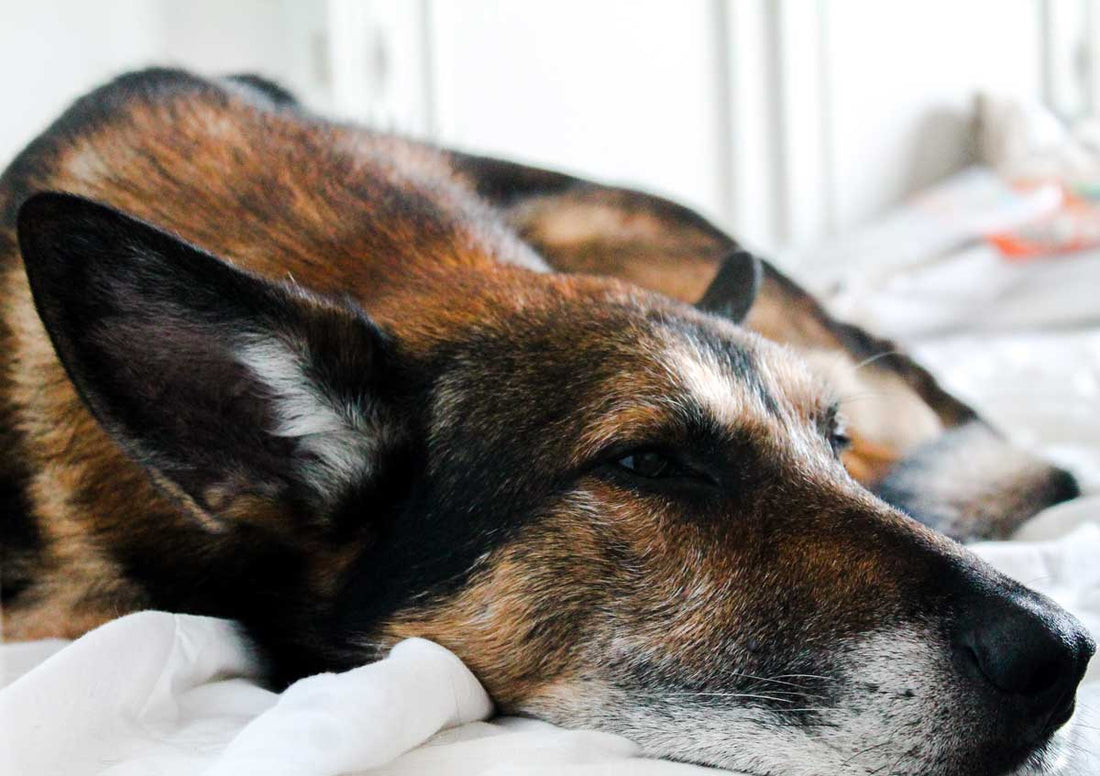If you have ever owned a large or giant breed dog, I’m sure someone has warned you against the dangers of GDV (Gastric dilation volvulus) or “bloat”.
Gastric dilation volvulus (GDV) is a life-threatening condition that affects mostly large deep-chested breeds. This condition occurs when a dog's stomach fills with gas, leading to an abnormal rotation.
GDV is a veterinary emergency that requires immediate attention. In this blog, we will delve into what GDV is, the symptoms of GDV, the factors that contribute to its development, and the various treatment options available.

Image via the Veterinary Information Network (VIN); illustration by Tamara Rees
Understanding Gastric Dilation Volvulus (GDV)
What is GDV?
Let’s break this down a little further. Gastric (stomach) dilation (being made larger) volvulus (intestinal rotation) is a progressive condition that essentially cuts off the in/out routes of the stomach as it flips over or twists on itself.
Think of this like twisting a balloon while continuing to fill it with air. The stomach then continues filling with gas and the dog has no way of moving this air out.
Patients often feel like it's difficult to breathe with the growing stomach pressed against the diaphragm and will attempt to expel the contents of the stomach.
Think of a time when you ate far too much and felt like you couldn’t breathe. That’s because your stomach has enlarged and pressed into the diaphragm enough to restrict its movement.
This growing organ also begins to press on other vital components of the body, most notably the caudal vena cava (CVC). The CVC is responsible for returning blood from the abdomen back to the heart.
The “backing up” of blood in the draining veins of the spleen, kidneys, intestines result in hypotension, GI tract ischemia, hypovolemia, and systemic hypotension. GDV can result in tissue death in the stomach, intestines, and ultimately other organs impacted by the loss of blood movement.
It can also result in cardiac arrhythmias that must be monitored during and following GDV correction. These arrhythmias will typically resolve on their own over time but may need supplemental medications in some cases.
There are several other potential risks or outcomes associated with GDV. I encourage you to check out the reference links below to dive even deeper - if you’re interested in the nerdy stuff!

Image via the Urban Animal Veterinary
What Are the Causes of GDV?
Although the exact cause of this condition is still not fully understood, gastric dilation volvulus is believed to occur when several factors align. Contributing factors include:
-
Diet and Feeding Habits: Eating large meals quickly or consuming a single large meal a day may increase risk for “bloat.”
-
Breed Predisposition: Deep-chested breeds such as Great Danes, Doberman Pinschers, and German Shepherds are more susceptible; however, I personally have seen “bloat” in patients as small as 20 lbs (although rarely).
-
Age: GDV is more common in middle-aged and older dogs, but I’ve seen it in young pups, too! The hyperactivity of young dogs following feedings can be a contributing factor.
-
Stress: High-stress situations or anxiety can potentially trigger GDV.
-
Exercise After Meals: Strenuous activity immediately after eating may contribute to GDV.
What Are Symptoms of GDV?
Recognizing the symptoms of GDV is crucial for early intervention and you must act fast if your pet begins displaying these symptoms. The sooner your pet gets to a veterinary clinic the sooner action can be taken to attempt life saving measures for your pet.
The signs may include:
-
Abdominal Distention: The dog's abdomen appears swollen and tense due to gas accumulation. Many owners report their dog looks like he swallowed a basketball.
-
Unsuccessful Vomiting: Frequent attempts to vomit without producing anything. There is a tell-tell sound that these patients make that any veterinary professional can describe. If your pet is attempting to vomit and unable to produce anything seek emergency treatment asap.
-
Restlessness: The dog may appear anxious, pace, or unable to find a comfortable position. This is due to the enlarging of the stomach and pressure placed in the abdomen and on the diaphragm.
-
Excessive Salivation: Drooling or foamy saliva may be observed. Some owners may think their dog has choked on a toy or bone before realizing that bloat is the culprit.
-
Labored Breathing: Difficulty breathing due to the pressure on the diaphragm caused by the bloated stomach.
-
Pale Gums: The dog's gums may turn pale or bluish due to poor circulation as the CVC is being depressed and hypovolemic shock begins to take hold.
-
Rapid Heartbeat: An elevated heart rate is a common sign of GDV. The heart is working harder to move blood to vital organs.
-
Collapse: In severe cases, dogs may collapse or lose consciousness.

Gastric dilation and volvulus; image via Vet Focus at Royal Canin
Diagnosis and Veterinary Intervention
If you suspect that your dog is suffering from GDV, it is crucial to seek immediate veterinary assistance. The veterinarian will perform a series of diagnostic tests, including:
-
Physical Examination: The vet will examine your dog's abdomen for signs of bloating and perform a thorough physical assessment.
-
X-rays: Radiographs are often used to confirm the diagnosis and assess the severity of the condition. Many times, a receptionist or assistant will seek approval for a radiograph immediately to rule out GDV. This condition is life threatening to your pet and intervention must happen quickly.
Once GDV is diagnosed, the primary goal is to stabilize the dog and relieve the pressure on the stomach. This is typically achieved through decompression (insertion of a trocar or catheter into the abdominal wall to release trapped air) and surgery.
From the time you walk through the door with your pet to the point of diagnosis, it can take only minutes, and decisions must be made quickly to treat your pet appropriately.
Treatment Options for GDV
Surgery is necessary to correct the stomach's abnormal position and prevent future occurrences of GDV. During the procedure, the veterinarian will:
a. Untwist the Stomach: The twisted stomach is carefully untwisted to restore blood flow and assess the damage of tissues in the area.
b. Gastropexy: To prevent future stomach twisting, a surgical technique called gastropexy may be performed. This involves attaching the stomach to the abdominal wall to prevent rotation. This procedure reduces the risk of GDV in large breed dogs from 55% to only 4%!

Gastropexy diagram; image via LifeLearn Inc.
c. Tubal Decompression: To relieve the pressure in the bloated stomach, a tube may be passed through the dog's mouth and into the stomach. This allows gas to escape, reducing the risk of gastric rupture. A stomach tube is also placed during the surgical procedure to ensure that trapped gas and stomach contents can be emptied safely, reducing the risk of inhaling those contents (aspiration).
Postoperative Care
After surgery, dogs require intensive postoperative care, which may include intravenous fluids, blood chemistry monitoring, pain management, and close monitoring of vital signs including cardiac rhythms.
Because twisting of the stomach puts pressure on vital organs and blood supply, it is common to see arrythmias arise following restoration of blood as well as organ stress/damage that can be seen on blood work.
Post-Treatment
The recovery period after GDV surgery can vary depending on the dog's overall health and the severity of the condition. Dogs typically stay in the hospital for a few days and may require a restricted diet during the initial recovery phase.
If all goes well, your pet may be able to return home within 3-4 days following surgery with continued care at home.
GDV Prevention
Dietary Management
Feeding your dog multiple smaller meals throughout the day and using elevated feeding bowls can help reduce the risk of GDV. Keeping the head and stomach in an upright position during meals can improve digestion and reduce bloating.
No Strenuous Exercise After Meals
Avoid rigorous exercise for at least an hour after eating to prevent stomach torsion. Many owners choose to train their dogs beginning at a very young age to “settle” after meals. Others choose to crate their dogs for 30-60 minutes following meals to reduce activity.
Preventative Gastropexy
If your dog is at high risk for GDV due to breed or previous occurrences, a preventive gastropexy can be considered. Many veterinarians advise this at the time of a spay/neuter but can be done at any time in young dogs.
Conclusion
Gastric dilation volvulus is a life-threatening condition that demands immediate attention and intervention. The mortality rate following GDV is reportedly around 20-45%.
Understanding the symptoms and risk factors associated with GDV is essential for early diagnosis and successful treatment. If you suspect that your dog may be suffering from GDV, do not hesitate to contact your veterinarian, as early intervention significantly improves the chances of a positive outcome.
Additionally, adopting preventive measures and lifestyle adjustments can help reduce the risk of GDV in susceptible breeds, ensuring the long-term health and well-being of your beloved canine companion.
That wraps up Part One of the most common veterinary emergencies! Stay tuned for Part Two where we talk about urinary blockage in cats!

